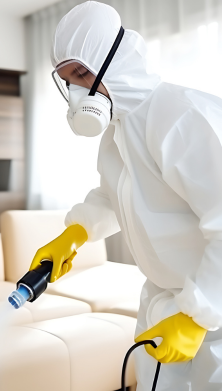This article is part of the
Global Risk Dialogue - Spring/Summer 2022
The 1 minute dialogue
- Escapes of water often go unnoticed in commercial premises if they happen at weekends or when no personnel are present
- Frozen pipes is a common cause of loss as low temperatures/ice can cause pipes to split or move. When they thaw water can escape
- As well as damaging buildings and property, water can also destroy valuable confidential documents and artwork and can cause significant business interruption losses
- Leak detection and flow-monitoring systems, as well as preventive maintenance, can head off or mitigate water damage
If the restaurants and bars of Calgary, Canada, weren’t reeling enough from the financial blows the Covid-19 pandemic has inflicted, they received another kick at the end of 2021. A cold snap over the Christmas holiday weekend meant staff returned to find burst pipes and flooded premises at some businesses.
On December 29, Native Tongues Taqueria, an upscale Mexican restaurant, posted a video [1] of water pouring into the restaurant like a torrential downpour. Kevin Warner, an Assistant General Manager at The Unicorn, another local bar affected by the cold spell, said it was just one more body blow for the business. “It seems like any time you gain some momentum, something knocks you down…” he commented to the Calgary Herald [2].
Escape of water damage from frozen and burst pipes is one of the most common domestic property insurance claims. It is also a surprisingly regular source of damage in the commercial sector.
In a study of over 470,000 claims [3] from 200 countries and territories over a five-year period, Allianz Global Corporate & Specialty (AGCS) found water damage accounted for the third-highest number of insurance claims for global business (6% overall) and was also the eighth top cause of loss according to value of claims (3% overall). Water damage includes such incidents as:
- flooding damage in basements
- flooding due to burst pipes
- water damage resulting from condenser water system failure
- boiler leakage.
“Every type of commercial property – offices, shopping centers, hotels, high-rise buildings, you name it – has a network of pipes that connect to a water supply,” says David Vanek, Account Engineering Manager MidCorp for Allianz Risk Consulting, AGCS. “Failure of older and poorly-maintained sprinkler and plumbing systems can result in large property damage and costly business interruption losses.”
On its way through a building, water can cause significant damage to everything in its path. “This includes floors, walls, ceilings, insulation, furniture, computer, electrical and mechanical equipment,” says Vanek. “It’s therefore crucial that building owners and property managers understand their exposure, so water damage losses can be either prevented or mitigated.”
According to another claims analysis conducted by AGCS, North American insurers alone have paid out claims totaling more than $2bn over the past 10 years resulting from water damage. In commercial property the worst events can cause millions of dollars’ worth of damage.
It is not only the physical destruction driving these costs. The resulting damage can lead to a business interruption loss and possibly create a liability claim by guests, tenants, or other property owners.
Weekends, holidays and out of hours a problem
Many water damages result from leaks in pressurized drinking water or fire water systems, which often go unnoticed because the release occurs at weekends or when no personnel are present. These leaks are most costly when interior work has been completed, or water-sensitive equipment was installed before the pipe burst.
In addition to expensive repairs, rework can also lead to project delays. In a famous 2010 incident [4], the Deutsche Bank twin towers in Frankfurt made headlines when water in one tower flowed from the ninth floor to the basement and in the other from the sixth floor downwards, causing extensive damage after the towers had been renovated.
While many damages could be avoided if existing water pipes and water-bearing fittings were regularly checked and maintained, carelessness and the lack of monitoring on non-working days are often one of the main causes of damage in construction projects. Water damage was the third most frequent driver of construction losses during the first three quarters of 2021, accounting for 11% of claims received, according to AGCS claims analysis. It was also the fifth most expensive cause of loss.
If a system is shut down over the weekend or holidays, but there is residual water in the pipes, it can freeze in low temperatures and the pipes can burst. AGCS claims analysis in Germany showed that on New Year’s Eve alone, more than 36% of all property insurance claims over 10 years could be attributed to this cause, with the chemical industry particularly affected.
“We repeatedly see losses occurring on public holidays, weekends, and out of hours when many employees are absent or there is only a limited workforce on site to detect any problems,” says Manfred Schneider, Regional Head of Risk Consulting Engineering and Construction, AGCS Central & Eastern Europe.
Water always finds a way
Typically, the water pipes that burst in winter are ones that have frozen. While water has a density of 1g/cm^3, ice is less dense with 0.92g/cm^3 – that is why it floats. Forget the mathematics; this means when water freezes into ice, the amount does not change, but the volume does – by about 9% more. This places pressure on the pipes, causing them to split or a joint to move. When the ice thaws, water escapes.
Of course, water escapes do not only happen in freezing winters. The first time Gordon Lee saw a burst pipe was when he was a young engineer involved in a railway viaduct project in Hong Kong. An excavator punctured a pipe while working on an adjoining road for the project.
“The gush reached four to five stories,” Lee recalls. “The power of water under pressure can be astounding. The big problem was that it was seawater.”
In Hong Kong, scarce freshwater supplies are not used for flushing toilets; instead seawater is used, reducing the city’s freshwater consumption by about 20%.
“But the problem with seawater is it can be particularly corrosive, and there were a lot of cars in the area that sustained damage to their components or finishes.”
Today Lee is a Senior Risk Consultant for AGCS in the Asia Pacific region. He is also Global Expert Group Leader for Construction and Heavy Construction. He explains bursts caused by aging or poorly-maintained pipes or accidents happen more often than you imagine.
During renovation work on an office/retail tower five years ago, workers hit a seawater pipe in one of the higher floors. The water cascaded down through lawyers’ offices with confidential documents and into storage space for luxury brands in the underlying mall.
“Claims can quickly mount up in such situations or on construction projects,” says Lee, “particularly if business interruption is a factor.”
Sinkholes caused by burst pipes

Conversely, although they look dramatic, sinkholes rarely see claims as high. Although there can be many reasons for sinkholes, one common cause is when an underground pipe bursts. Water pipes are typically two to three meters below ground, and the power of the water erodes the surrounding soil, forming a sinkhole that collapses, swallowing objects on top of it.
In June 2021, a giant sinkhole [5] opened below a hospital car park in Jerusalem. The cause is believed to be a nearby highway tunnel project. While the sinkhole swallowed cars, the loss is likely to be comparatively light, Lee estimates. “In comparison, during building construction projects, a lot of equipment can be stored for security reasons in the basement,” says Lee. “If there is water escape, the basement is where the water pools and a lot of damage to expensive equipment can result.”
Close monitoring for damage minimization
References
[1] Twitter, December 29, 2021
[2] Calgary Herald, Cold Snap Has Some Calgary Restaurants and Bars Dealing with Burst Pipes, Floods, December 29, 2021
[3] Allianz Global Corporate & Specialty Global Claims Review: The Top Causes of Corporate Insurance Losses, December, 2018
[4] Spiegel, Unbekannte Setzen Deutsche-Bank-Tuerme Unter Wasser, November 14, 2010
[5] The Indian Express, “What a Nightmare”: Watch a Sinkhole Swallowing Cars at Parking Lot in Jerusalem, June 10, 2021
Pictures: Adobe Stock
Innovative solutions for surveillance and leak detection
- Property-wide remote protection systems: These allow the shutting off of water supply after hours or during extended absence at the touch of a button, protecting property from flooding by failed plumbing lines, split hoses or ruptured fixtures. They can monitor temporary work sites such as rented office buildings and construction sites and detect the entry of liquids into rooms and containers.
- Point-of-use detection systems: An economic option to help prevent damage caused by aging or malfunctioning pipes or appliances, they shut off water supply to selected valves when a leak is detected.
- Leak detection alarm systems: These use strategically placed sensors to detect water-flow abnormalities, such as on pressurized drinking water or fire-water pipes, and sound an audible alarm. Used with a monitored alarm system, they can signal to an offsite monitoring station or point of contact after hours for added protection. A failed circuit alarm is another option, for appliances such as hot tubs or pumps where it is important to know if a breaker or fuse has blown or if there has been a power outage.



















